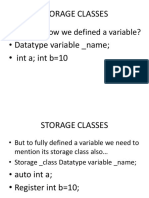0% found this document useful (0 votes)
10 views31 pagesChapter 09 - Storage Classes of Variables
Chapter 9 discusses the storage classes of variables in C, detailing four types: auto, register, static, and extern. Each storage class defines the variable's storage location, default initial value, scope, and lifetime. The chapter includes programming examples to illustrate the differences and behaviors of these storage classes.
Uploaded by
Bandana Priyadarsini JenaCopyright
© © All Rights Reserved
We take content rights seriously. If you suspect this is your content, claim it here.
Available Formats
Download as PDF, TXT or read online on Scribd
0% found this document useful (0 votes)
10 views31 pagesChapter 09 - Storage Classes of Variables
Chapter 9 discusses the storage classes of variables in C, detailing four types: auto, register, static, and extern. Each storage class defines the variable's storage location, default initial value, scope, and lifetime. The chapter includes programming examples to illustrate the differences and behaviors of these storage classes.
Uploaded by
Bandana Priyadarsini JenaCopyright
© © All Rights Reserved
We take content rights seriously. If you suspect this is your content, claim it here.
Available Formats
Download as PDF, TXT or read online on Scribd
/ 31























































































